The Best-Case Scenario for Global Diabetes Spending
A study published last month in Diabetes Care finds that the global economic burden of diabetes – from adults alone – will increase to at least $2 trillion by 2030.
The global burden was estimated at $1.3 trillion in 2015. Researchers at the University of Göttingen used epidemiological and demographic data in addition to GDP forecasts from 180 countries to predict the increase in costs from 2015-2030. They imagined three scenarios:
- Diabetes prevalence and mortality increase only as the global population ages and moves into cities (the “baseline” scenario).
- Diabetes prevalence and mortality increase at the same rate as in the past (the “past trends” scenario).
- Diabetes prevalence and mortality achieve global targets set forth by the United Nations Sustainable Development Goals (SDG) and World Health Organization (WHO) Global Action Plan (the “target” scenario).
In the baseline scenario, the researchers predict that diabetes will cost $2.2 trillion. They anticipate $2.1 trillion in the target scenario and $2.5 trillion in the past trends scenario — this means that these costs will likely account for 1.8-2.2% of global GDP in 2030. The researchers predicted that costs would still increase by about $1 trillion if global goals are met in the target scenario.
The global targets set forth by the UN and WHO are lofty. They include:
- Achieve universal health coverage, including financial risk protection, access to quality healthcare services, and access to safe, effective, quality, and affordable essential medicines and vaccines for all.
- Reduce the relative risk of premature mortality from diabetes by 25%.
- Achieve a 10% relative reduction in the prevalence of insufficient physical activity.
- Halt the rise in obesity and diabetes rates.
Though we commend the UN and WHO for producing such admirable goals, we are not confident that their target scenario is realistic. However, the projections for this scenario are telling — even with significant changes to health policy and behaviors, our diabetes-related spending will still reach astronomical levels. This estimation should only encourage us to take greater action to stem this crisis.


